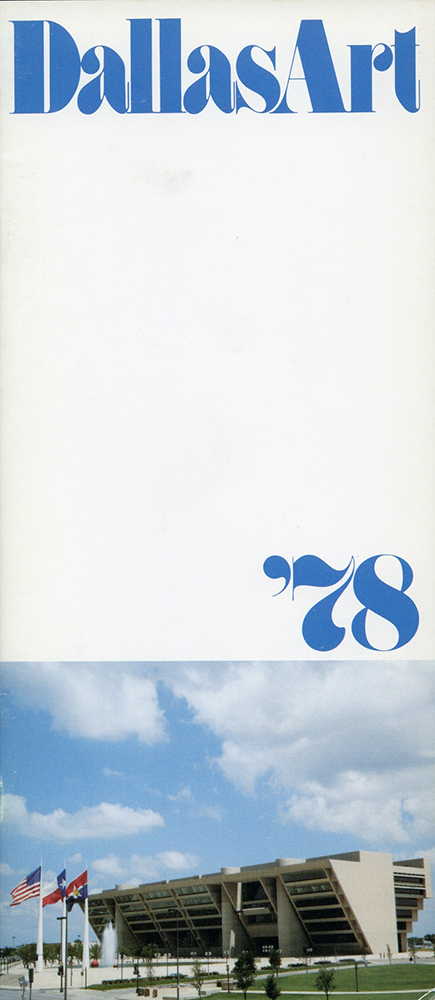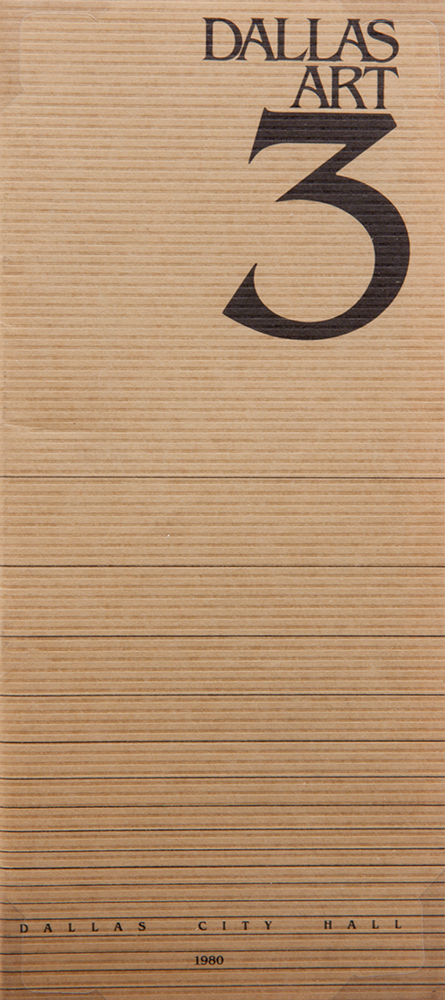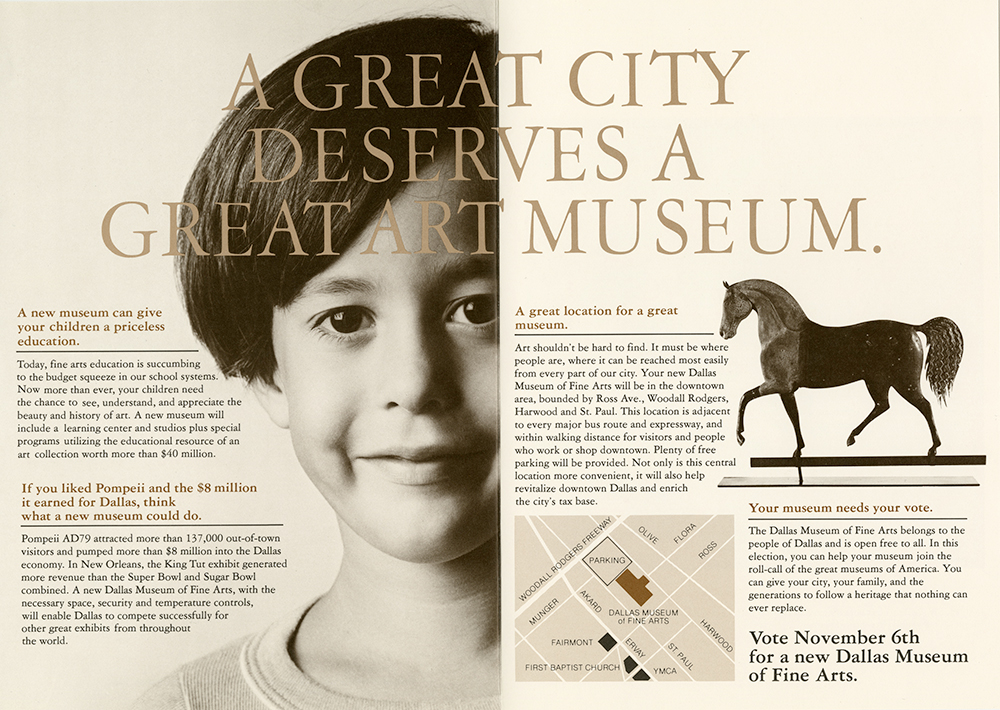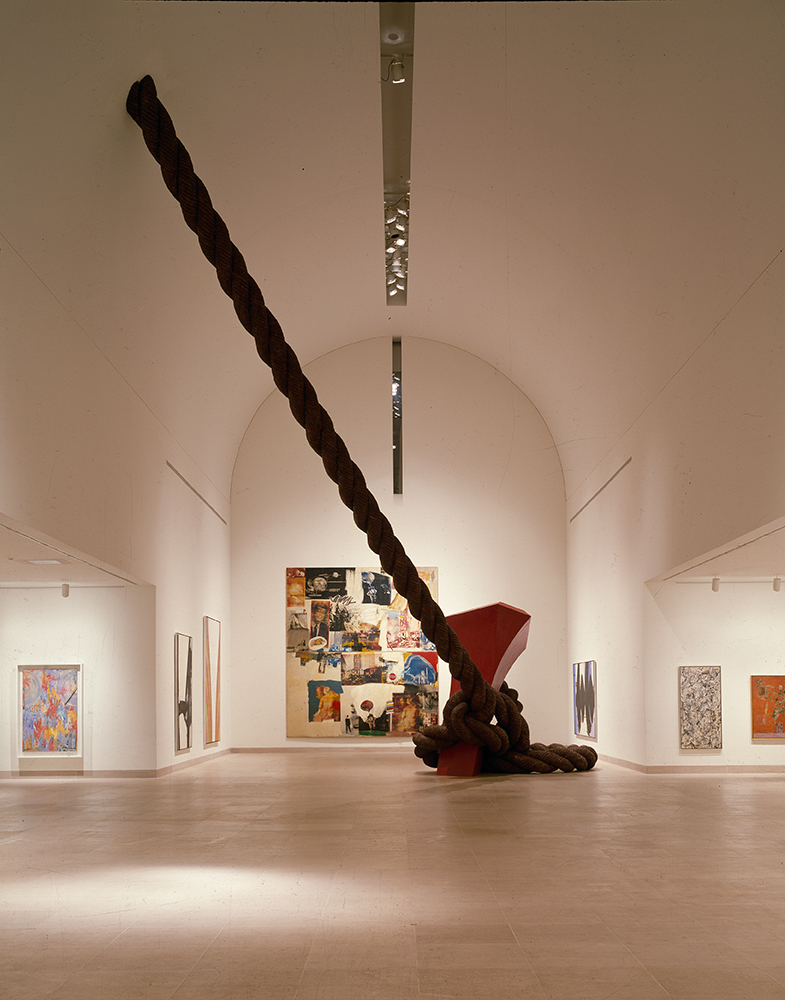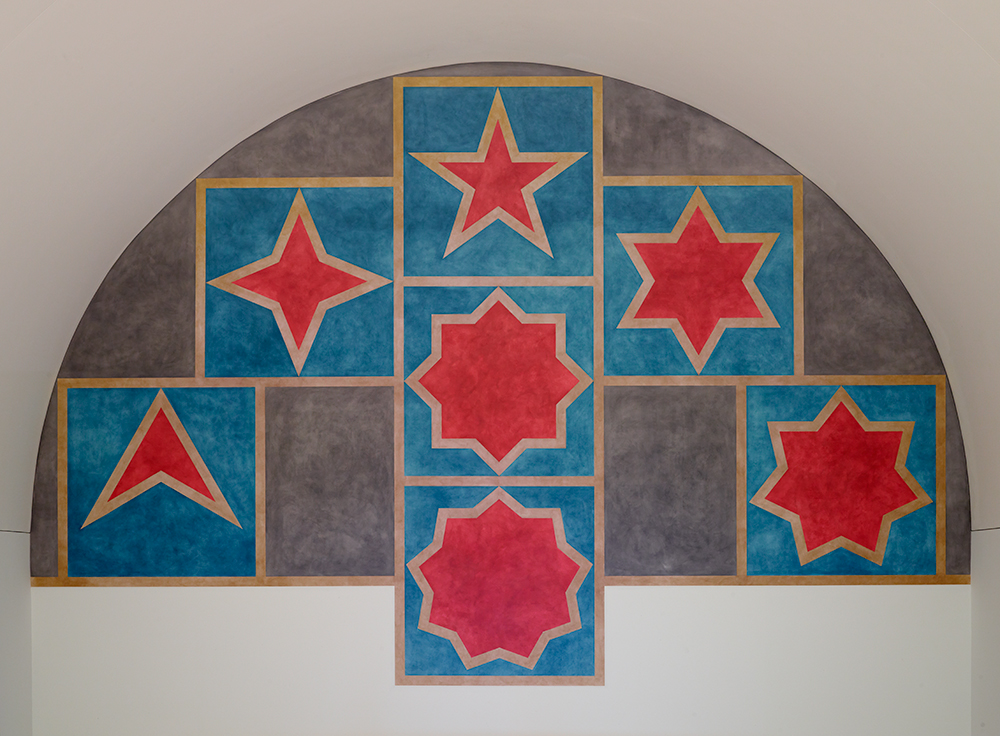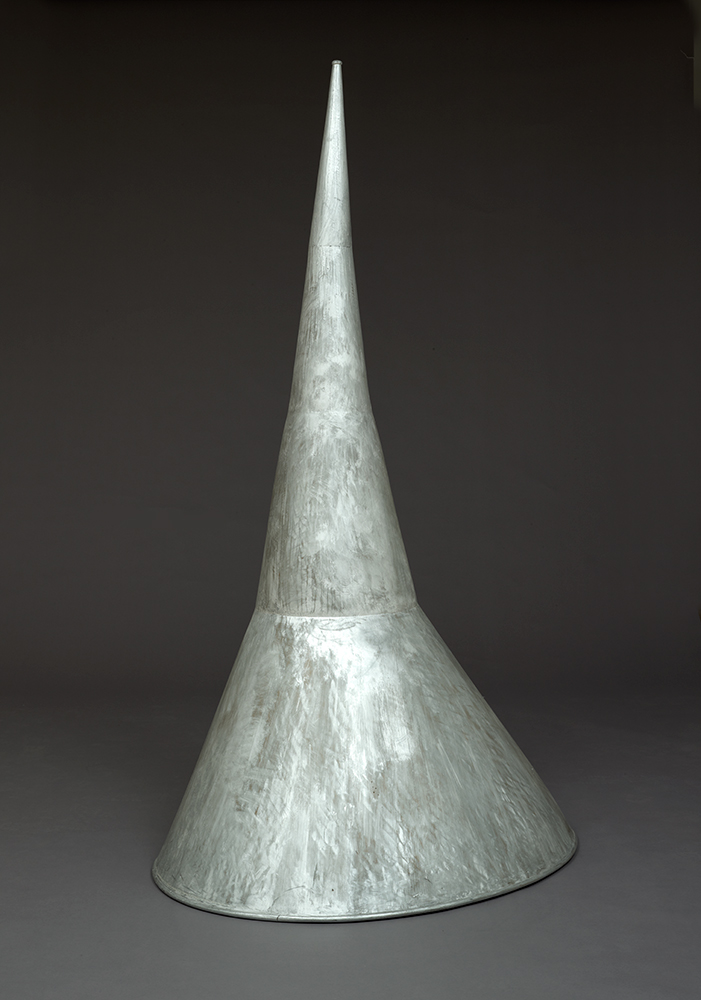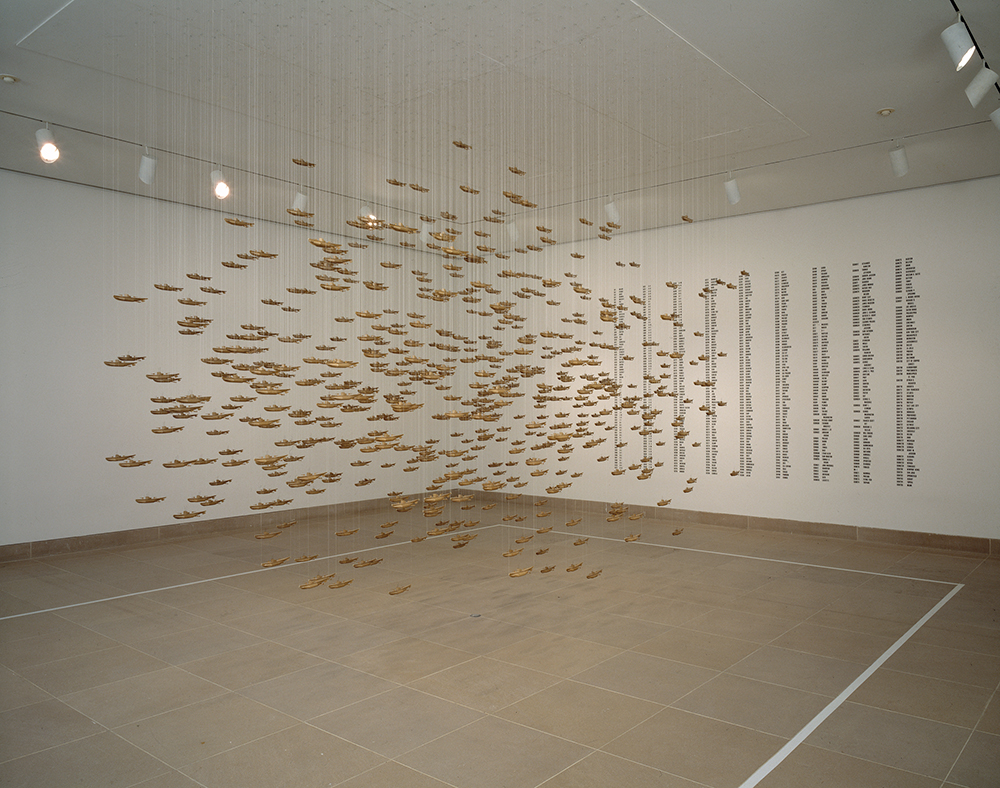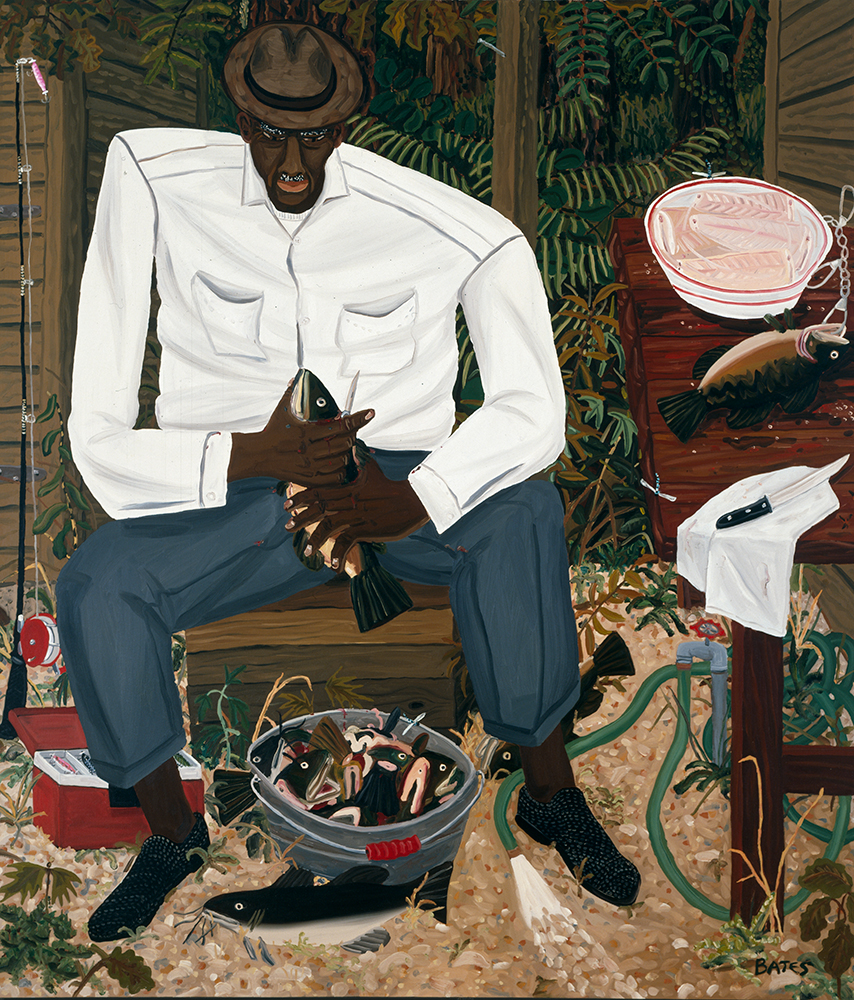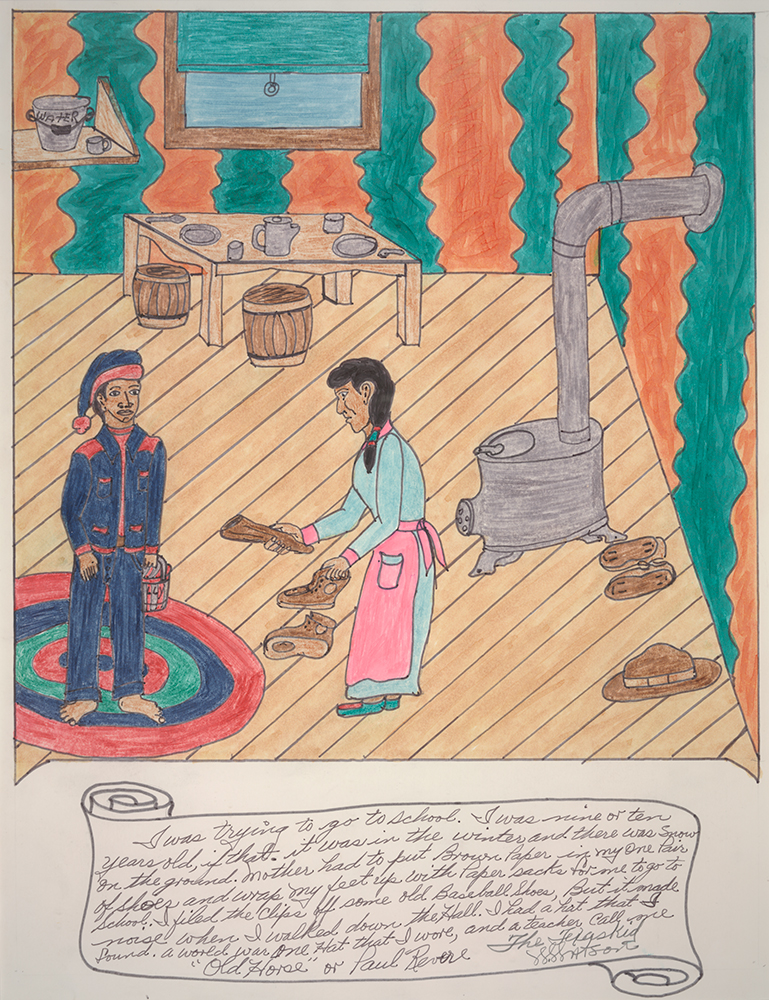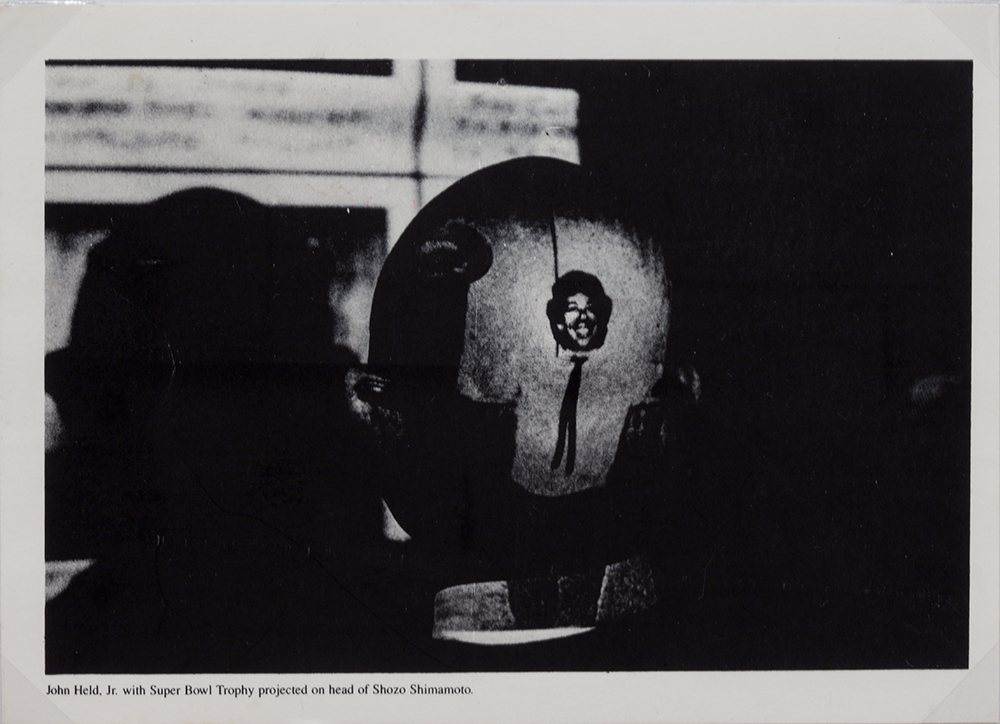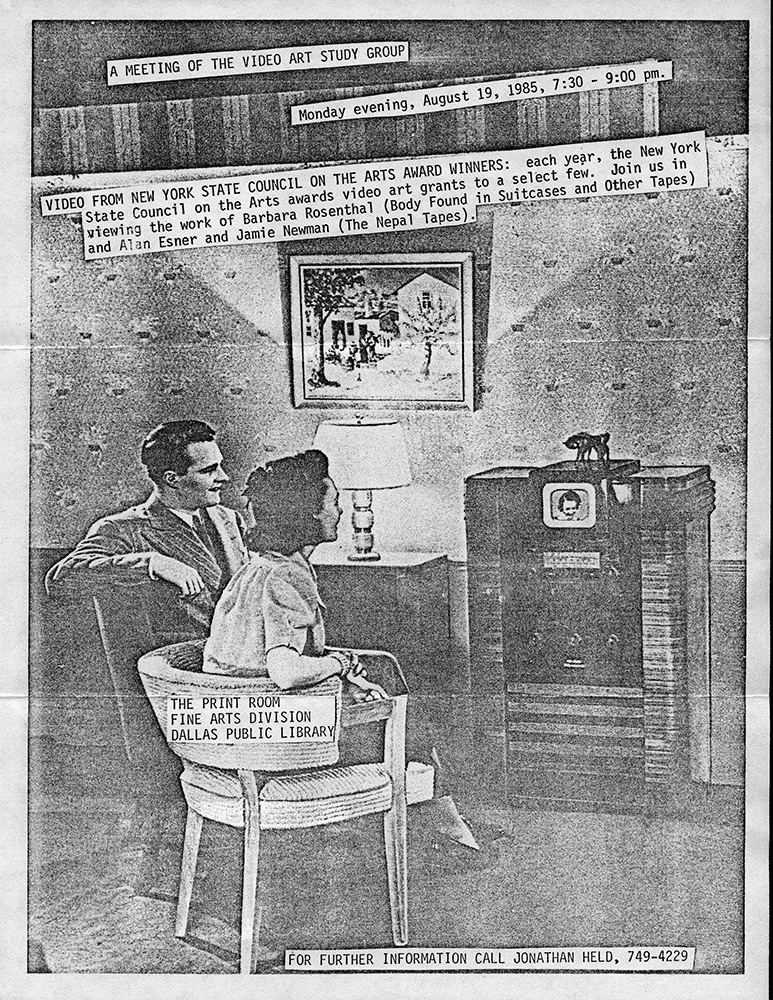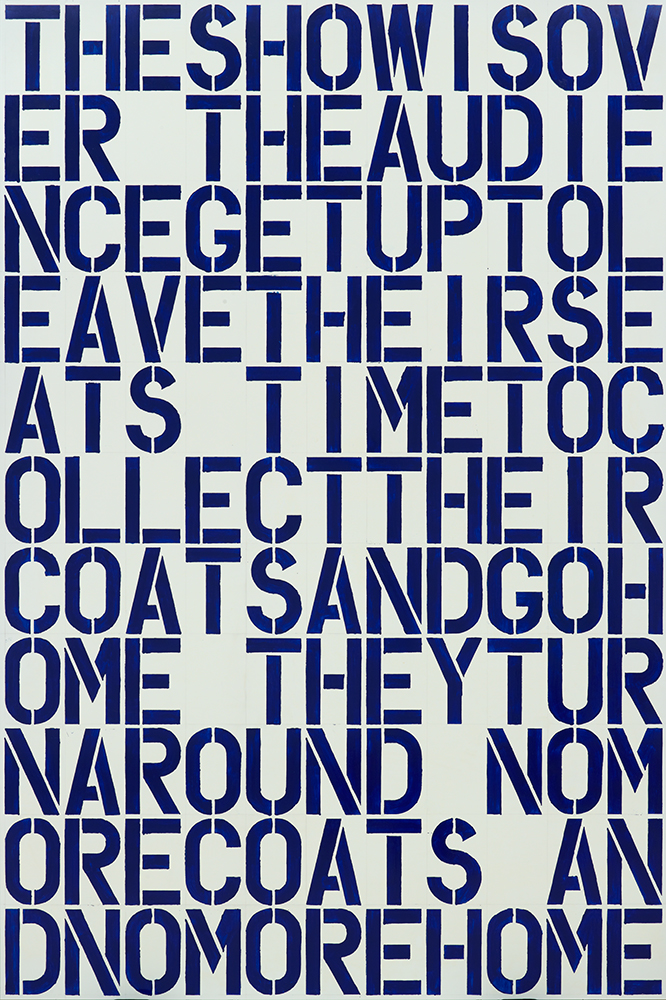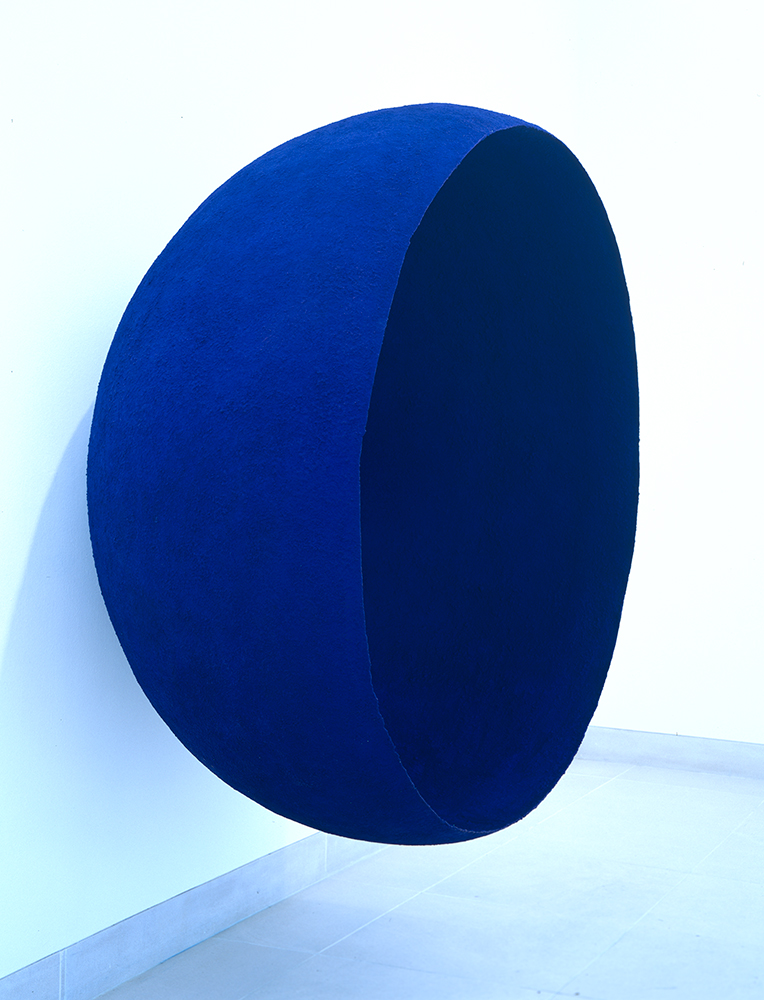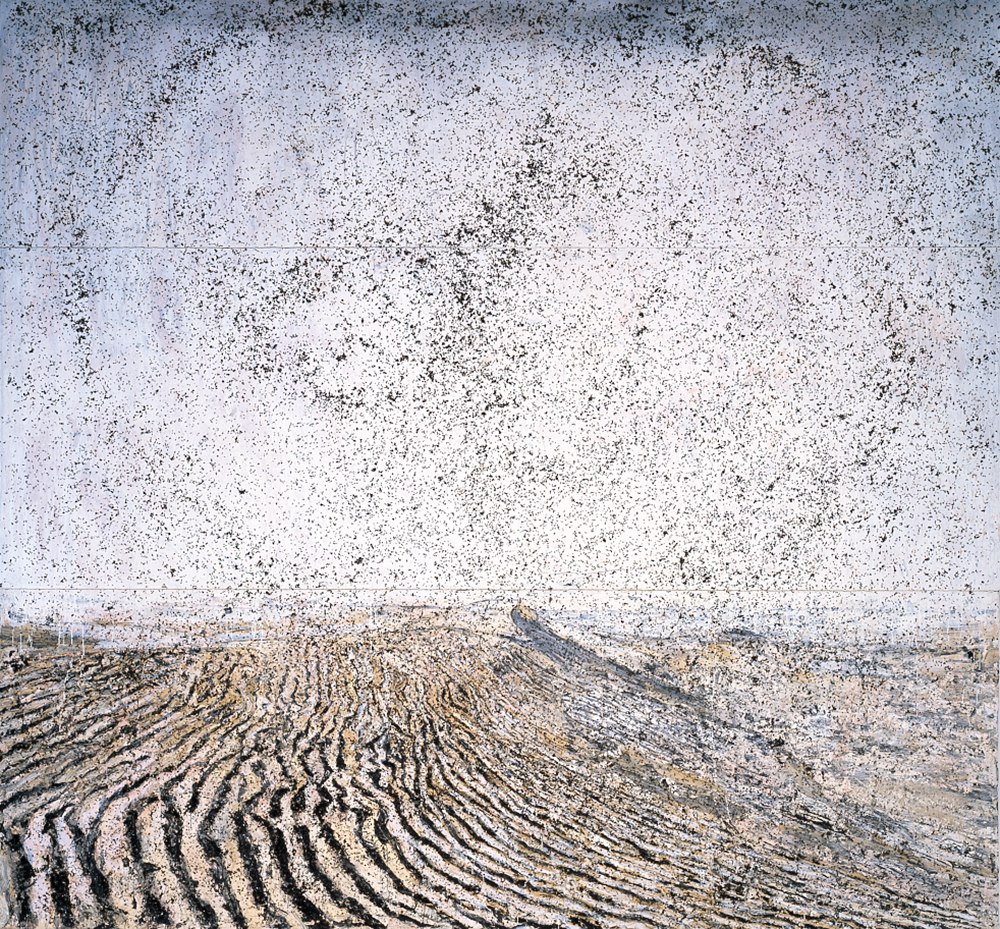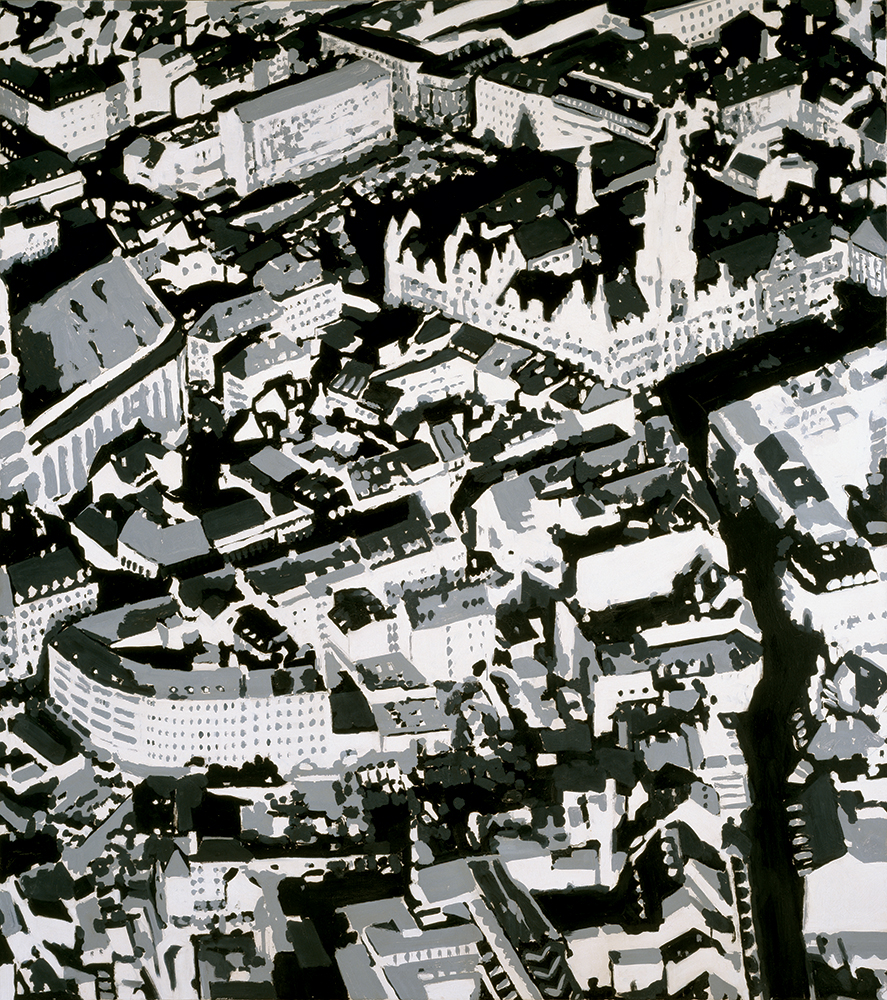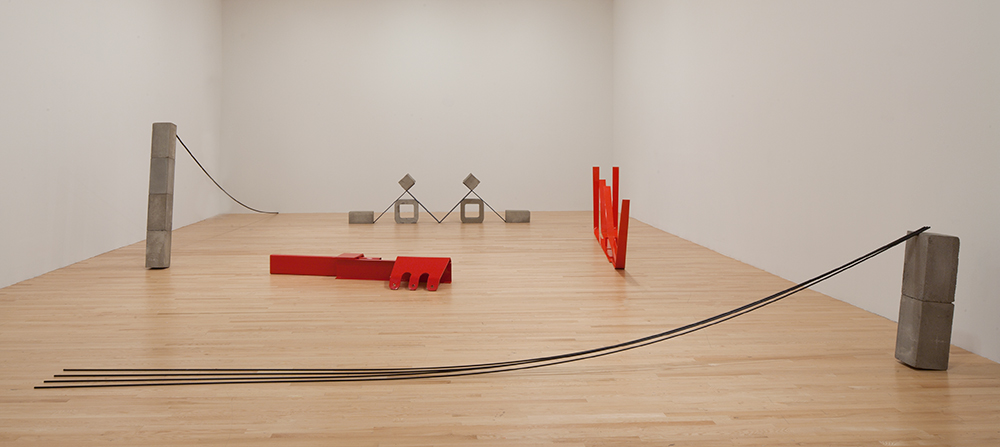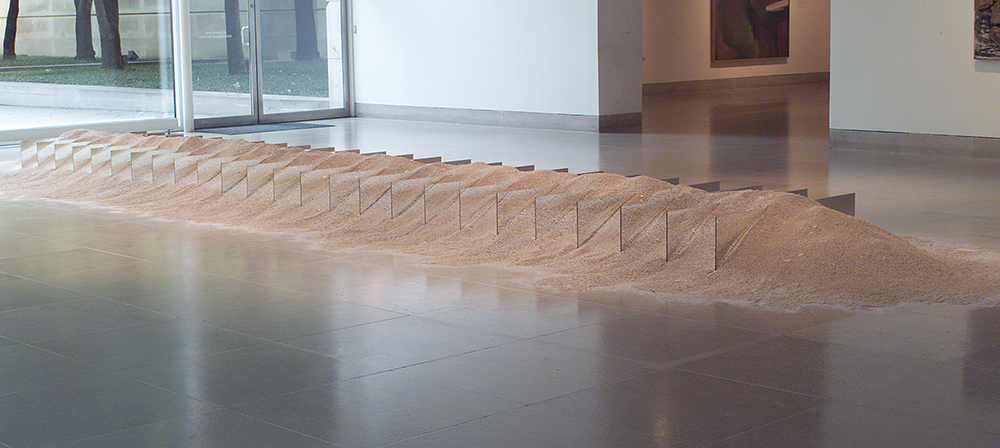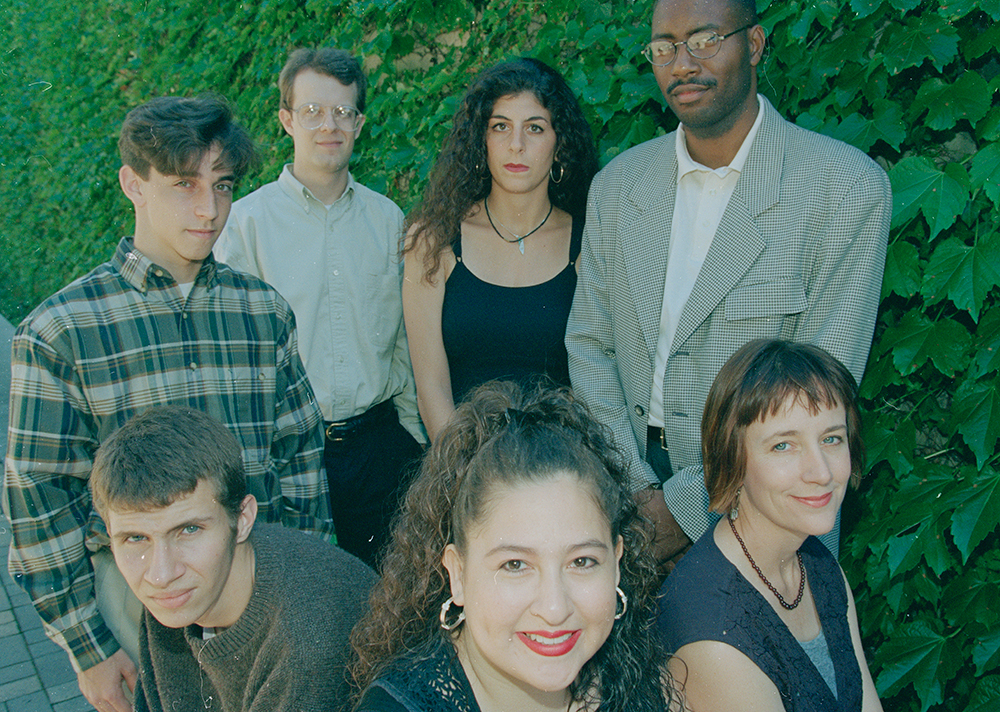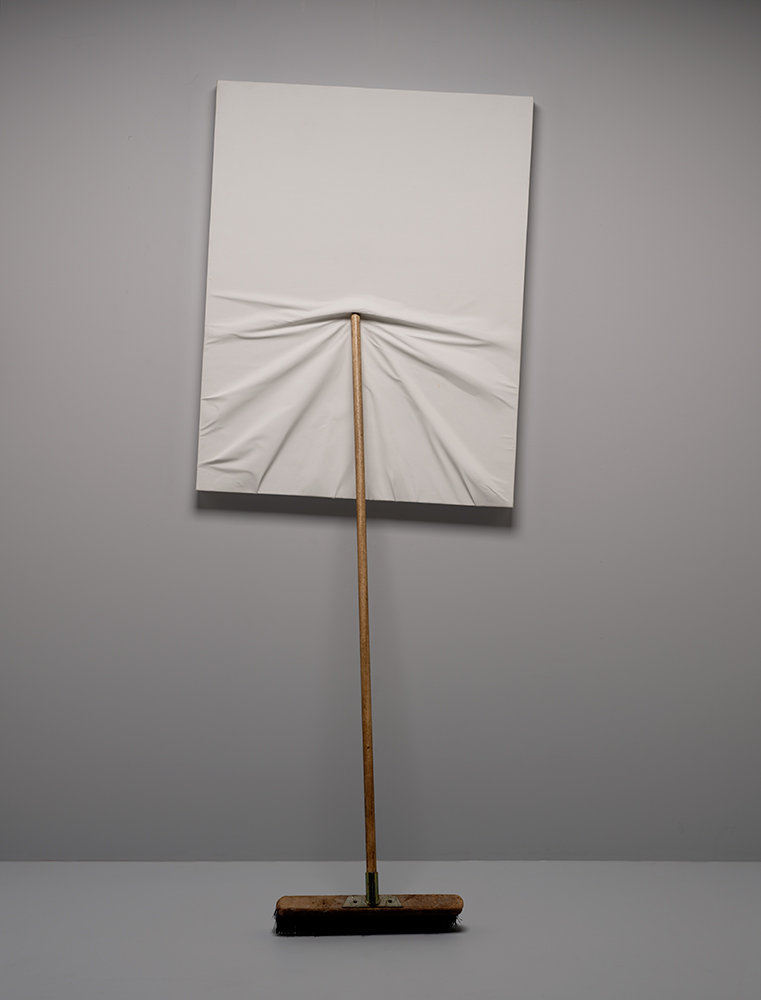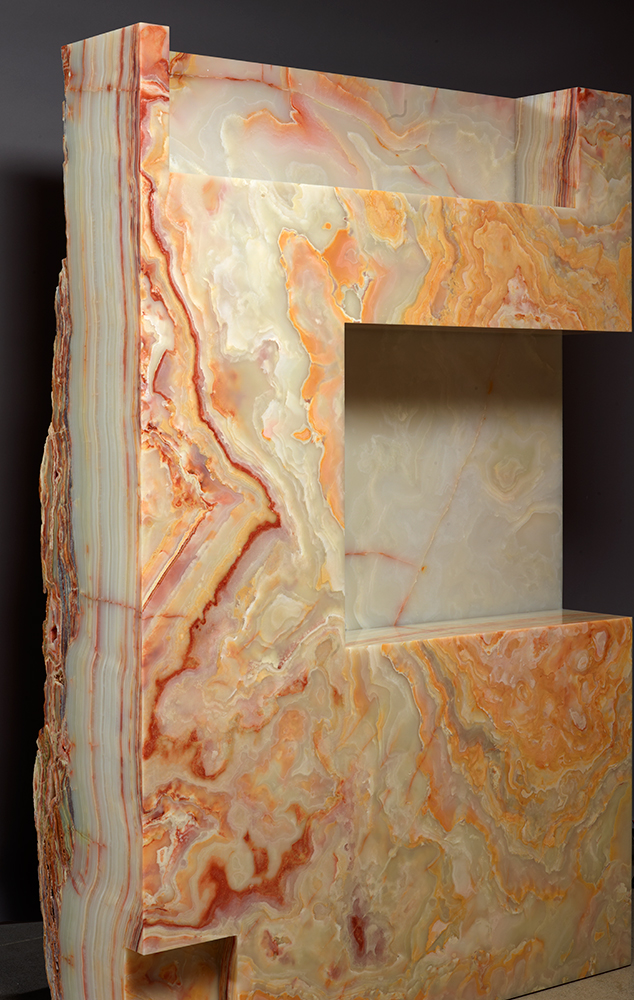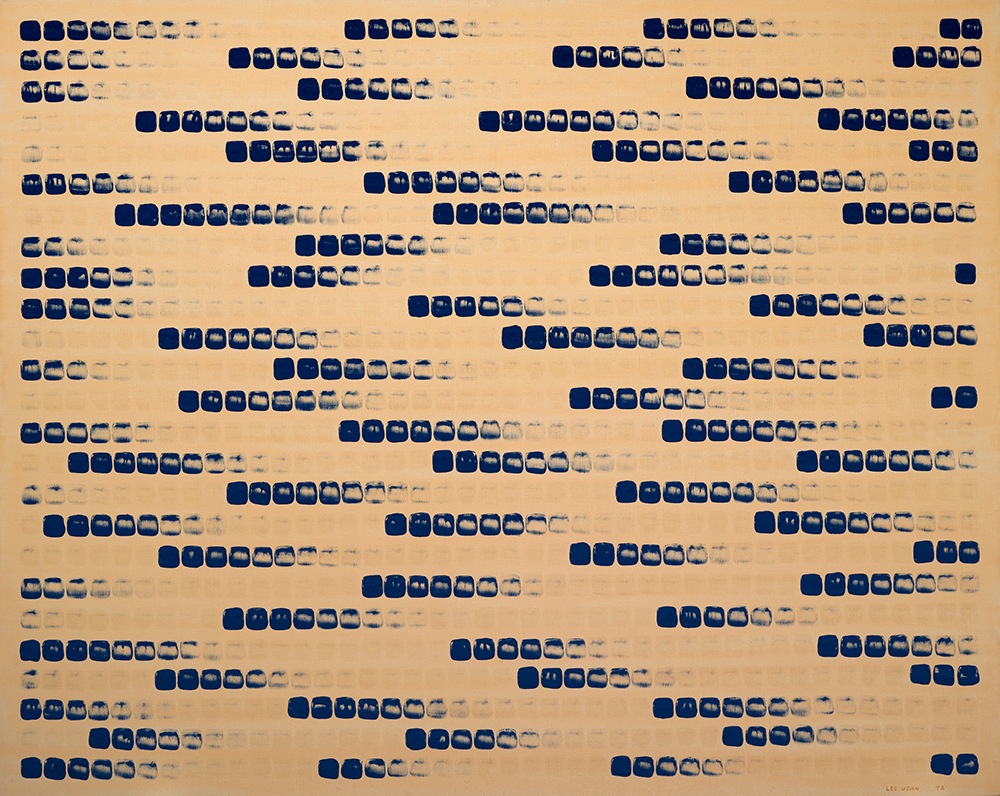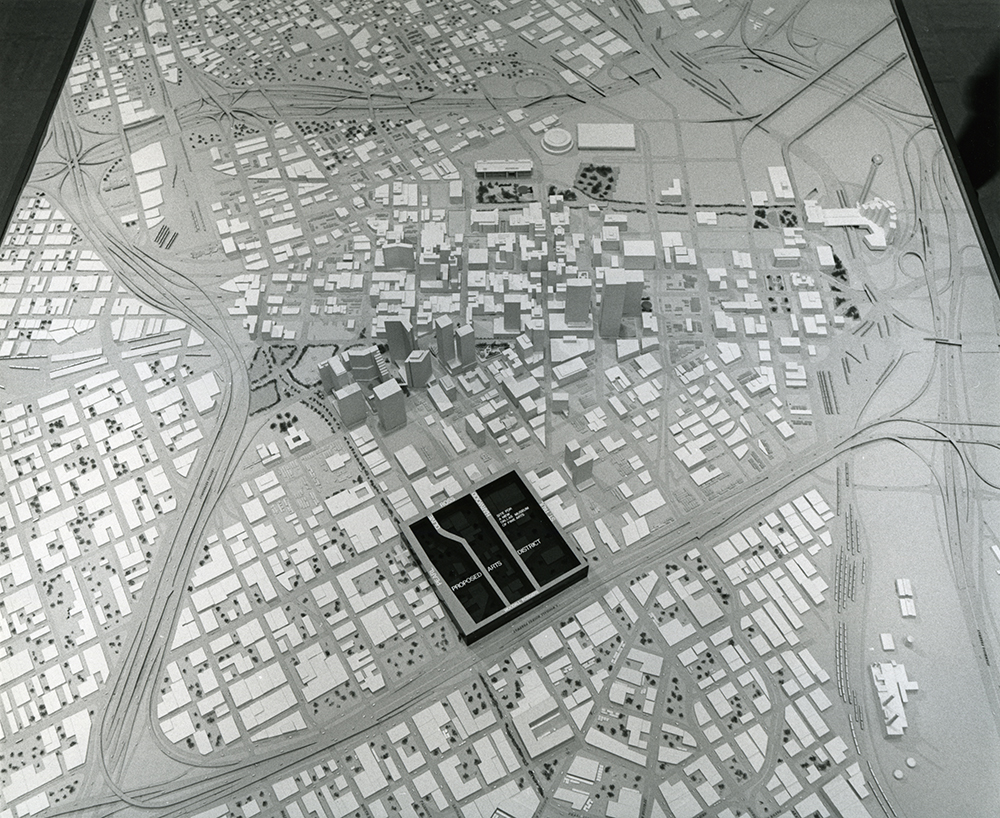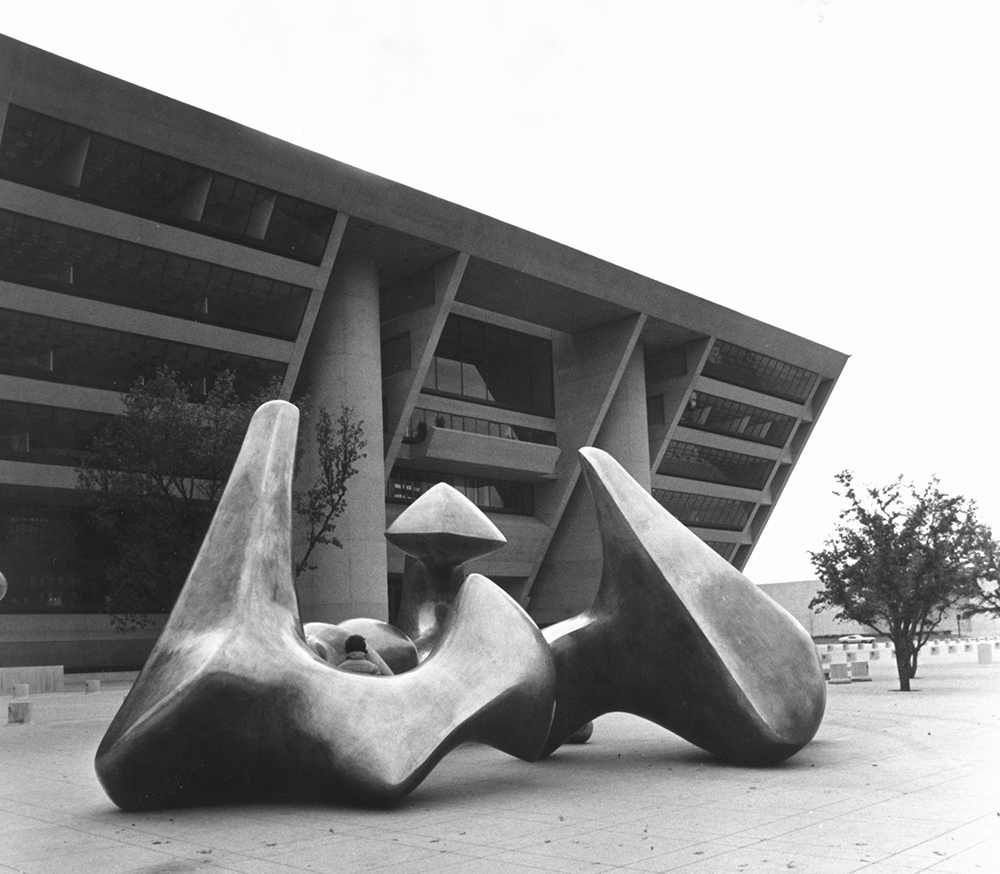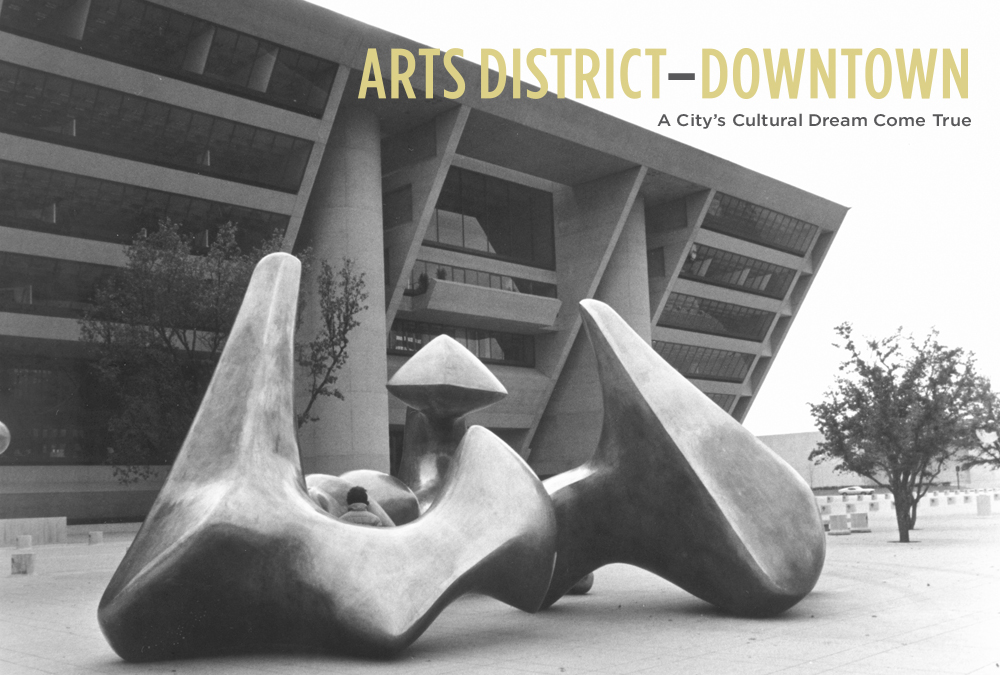Business and the arts converge in Downtown Dallas. Major corporations have their headquarters in the skyscrapers that have become a symbol for the city’s status as a growing and successful business center, while artists, galleries, alternative spaces, and leading arts institutions fuel an energetic, varied arts scene. The Main Street District—one of eight districts in Downtown (Fig. 1)—was the original city center and the first area where the arts thrived. Although the creation of the Arts District spurred a revitalization of Downtown in 1984 with the opening of the Dallas Museum of Art, the arts have always had a dynamic presence there.
The intersection of business and the arts in Downtown Dallas started as early as the 1930s, when Neiman Marcus introduced the Decorative Galleries on the fourth floor of its Main Street flagship store and staged exhibitions of paintings, sculpture, photography, and works on paper. The tradition of showing fine art in a department store setting was well established by the time the galleries opened, and for many years they were one of the few places to look at art Downtown.
After World War II, Dallas joined the nationwide population movement from cities to suburbs, as families and businesses relocated to communities to the north and west. Improved roads and new major highways connected these peripheral areas, and the automobile reigned supreme. With the conveniences offered in suburban shopping malls like Preston Shopping Center and Raymond Nasher’s NorthPark Center, suburban residents no longer needed to shop in the Central Business District. The bustling street life that once characterized Downtown Dallas slowly became a thing of the past.
The 1950s and 1960s
The 1950s and early 1960s were a relatively quiet period for the arts in Downtown Dallas. There were more galleries and artists in the neighboring area of Uptown and outside Fair Park because of the activity around the Dallas Museum for Contemporary Arts (1956–1963) and the Dallas Museum of Fine Arts. When the two institutions merged in 1963, local galleries became the place to view contemporary art. The city experienced a gallery boom along Maple Avenue, McKinney Avenue, Fairmount Street, and Cedar Springs Road in Uptown in the 1960s. The growing gallery system eventually spread to other neighborhoods, with several galleries opening in Downtown in the mid- to late 1960s.
In 1962, Mr. and Mrs. Van L. Stokes opened the Downtown Gallery in the Hartford Insurance Building at 1919 Pacific Avenue in the Main Street District. Established to exhibit the work of local professional artists, the gallery debuted with a show of work by Lea Steinnasser, David Hanna, and Buddy Mitterman. For several years, it was one of the only fine art galleries in the area. By 1969, the neighborhood had welcomed two new spaces: the Main Place Gallery, which opened in a new office tower at One Main Place in 1968 and specialized in contemporary American, European, and regional art, and Mr. and Mrs. Bill Burford’s Texas Art Gallery, which opened in the Adolphus Hotel at 1400 Main Street in 1969 and emphasized western and Texas regional art.
Donald Vogel was president of the Main Place Gallery, an extension of his first gallery, Valley House in North Dallas. Directed by Charles Sikes, who was assisted by Colette Weber and Violet Hayden Dowell, Main Place gave Vogel more square footage and the freedom to try new things. Group exhibitions featured Valley House artists like Michael Frary, Kelly Fearing, Loren Mozley, and Charles Umlauf, as well as new artists whose work was more appropriate for the new space. Its high ceilings could accommodate large-scale sculpture by artists like Canadian sculptor Sorel Etrog; New York sculptor Thea Tewi, who worked in fine natural materials like marble and onyx; and Kansas native Mac Whitney, who has since made a career in large-scale steel sculpture, working in Ovilla, Texas. The hardship of running two galleries took its toll on Vogel, and he closed Main Place Gallery in 1973 with an exhibition of primitive artifacts.
With the gallery district well established in Uptown, there were fewer places for young and emerging artists to showcase their work in Downtown Dallas. By the late 1970s, there was only one gallery left in the neighborhood. In 1978, local artists and artist rights advocates John Schrup and Sally Tobin established the Gallery for Dallas Artists, tucked inside the Jas. K. Wilson Co. department store at 1515 Main Street. Exhibits were organized under the auspices of the local chapter of Artists Equity, of which Schrup and Tobin were members. The inaugural exhibition included work by Artists Equity members Jeanne Mason Koch, Ruth Natinsky, Annelies Kahn, Laurence Scholder, and James Allumbaugh. During the year the gallery was open, it hosted exhibitions by Rowena Elkin, Linda Finnell, Dana Smith, Carlos Vargas, Susan Schiels, and Carol Wilder, all Dallas artists.
The establishment of El Centro College in the West End Historic District in 1966 helped liven up the streets of Downtown Dallas. In its first year, the flagship campus of the Dallas County Junior College District organized a festival celebrating the work of students and faculty in music, drama, art, and speech. The Echo Lounge, the college’s fine art gallery, gave students and faculty the opportunity to organize exhibitions and display their work. Over the years, many of Dallas’ most recognizable artists, including James Stover, Arthur Koch, David Bates, and Sharon Corgan Leeber, have taken classes or taught at El Centro.
The re-emergence of the arts in Downtown Dallas during the late 1960s was indirectly a result of a single event that remains a scar on the city’s history: the 1963 assassination of President John F. Kennedy. Dallas became known as the City of Hate, as the nation blamed it for the tragedy. Arlinda Abbott describes the atmosphere:
[It was a] tormented town. . . . When . . . Kennedy was assassinated, . . . Dallas’ pride in her civic center was in jeopardy. The proud cradle of the city’s history suddenly became a murder site recognized throughout the world. Public opinion polls, conducted shortly after the assassination, indicated over 80 percent of Americans had indicted “the people of Dallas” for the crime. . . . After the assassination, Dallas residents were harassed—telephone operators disconnected long-distance calls and restaurants refused service.
In 1964, newly elected Mayor Erik Jonsson proposed Goals for Dallas, a program to revitalize the city’s image that was put into place by 1966 with the help of prominent citizens. One of the most important goals was this one: “We demand a city of beauty and functional fitness that embraces the quality of life for all its people." In 1967 Jonsson persuaded the citizens of Dallas to pass a $175 million bond issue to finance the construction of three civic buildings: the Dallas City Hall, the Dallas Convention Center, and the Dallas Central Library. To launch the rebranding of Dallas, city officials commissioned architect I. M. Pei to design City Hall. Over the next decade, Pei designed four more buildings for Downtown Dallas.
The 1970s
The decade of the 1970s saw significant change in Downtown, both in infrastructure and in the arts. The city center began to grow vertically, as construction on some of the city’s most recognizable skyscrapers was started or completed. Several areas were revitalized amid the demolition and new construction, notably the West End Historic District (then described as the warehouse district of Downtown) and the Government District on the southern edge of Downtown.
Pei’s horizontal design for City Hall at 1500 Marilla Street included a large plaza with a circular pool and group of oak trees that faced the cantilevered façade. After completion of the building in 1977, discussion of a sculpture commission for the plaza began and soon centered on the British sculptor Henry Moore. After meetings among Pei, Moore, city official George Schrader, and local arts patrons, Moore was offered the commission. The sculptor had a congenial relationship with local art collectors Raymond and Patsy Nasher and with Dallas Museum of Fine Arts board member Margaret McDermott, who were all instrumental in securing the commission. Moore’s large-scale Three-Piece Sculpture: Vertebrae (The Dallas Piece) (Fig. 2) was installed in 1978.
Reaction to Dallas’ first major public sculpture was mostly positive, although one city official was initially resistant. Even before the work was in place, City Councilman William Cothrum bemoaned the choice of Moore, fearing that the sculpture would be too avant-garde for Texans: “The few works I’ve seen by the man . . . I’m not impressed with. . . . They’re a little too abstract to me and probably the average Dallas citizen. . . . I like things with a little more straight lines and rectangles, but that’s probably just my background in civil engineering.” His remarks were picked up by the Associated Press and published in the New York Times, making Dallas appear to the nation as conservative and closed-minded to contemporary art. In spite of Cothrum’s comments, the overall public reaction to the Moore piece encouraged the City of Dallas to continue with the idea of art in public places.
Once City Hall was completed, Dallas began to showcase local art talent there. In 1978, the City Hall Arts Committee organized Dallas Art ’78, which opened March 11 (Fig. 3). The 11-member committee, chaired by Irvin Levy, was a mix of Dallas arts benefactors, gallery owners, and artists, including Margaret McDermott, Billie Marcus, John D. Murchison, Arthello Beck, and Donald Vogel. The committee selected 40 Dallas artists to display their work in the corridors and lobby of the new building for the entire year. The concept was repeated the following year with Dallas Art ’79, although aspects of the program were adjusted. A three-member jury—Dallasite Paul Rogers Harris, director of the Waco Art Center; John Palmer Leeper, director of the McNay Art Institute in San Antonio; and Fort Worth Art Museum curator Marge Goldwater—selected work by 42 artists from a pool of more than 300 entries. The judges also awarded six prizes with funding from the Billie Marcus Memorial Fund of the Dallas Museum of Fine Arts. Award winners included painters Richard Shaffer and Jill Glover, photographer Daniel Barsotti, and sculptors Mac Whitney, Herb Rogalla, and Raffaele Martini.
The third Dallas Art exhibition at City Hall—Dallas Art III—was the most controversial, and consequently it would be the last (Fig. 4). Jurors Ron Gleason, director of the Tyler Museum of Art; Linda Cathcart, director of the Contemporary Arts Museum of Houston; and John Biggers, Houston-based artist and educator, reviewed 1,200 slides of work by more than 200 artists, but they were unable to select an exhibition because it was their collective opinion that the entries lacked quality. Gleason noted that the jurors “realized we were faced with pretty poor quality, and when we went back through the slides another time, we decided it would be a disservice to show the few good works submitted in that important a space or in company with other works of lesser quality.” Unwilling to abandon the project, Cultural Affairs Division administrators hastily organized a second jury, consisting of Laurence Scholder, Dallas printmaker and SMU professor; Lyle Novinski, local artist and chairman of the University of Dallas art department; and Deborah Papathanasiou, owner and director of the local Frontroom Craft Gallery. The second jury was able to select 60 works by 51 artists and award prizes to Linnea Glatt, David McCullough, Ann Lee Stautberg, Gilda Pervin, Dianne Taylor, and Jennie Haddad. Although the exhibition did get off the ground, the controversy prevented a wary Cultural Affairs Division from sponsoring the project for a fourth year.
Developing an Arts District
In 1977, the City of Dallas and nine cultural groups hired urban planner Kevin Lynch of Carr, Lynch Associates in Boston to investigate ways to revitalize Dallas’ business-centered downtown. Lynch concluded that the city would benefit from having all of its cultural institutions situated in one easily accessible place. The report concluded that “most of the city-wide arts institutions should in time relocate to a central location downtown for better access to all members of the community and because this best fits the needs of the institutions themselves.” The specific location—the north side of the Central Business District—was selected over areas like Fair Park for its neutral status: “It is accessible to everyone, is nobody’s turf, provides good public transportation, and might make downtown come alive 24 hours rather than just during the day.”
At the time of the study, the Dallas Museum of Fine Arts was looking for a new location. The building had been expanded in 1965 under director Merrill Rueppel, but it was still too small to accommodate the growing collection and exhibition program. The Museum needed larger quarters, and director Harry S. Parker III was determined to see it happen. With the results of the study, Parker and the DMFA Board had a suggested location for the city’s new cultural hub. But the 1978 defeat of a bond proposal to fund new buildings for the DMFA and the Dallas Symphony Orchestra and the renovation of the Majestic Theatre threatened to end the idea of an Arts District. In anticipation of passing a revised bond package, the DMFA obtained options on key tracts of land in the area suggested by Carr, Lynch and accrued private financial commitments totaling several million dollars. A nonstop promotional media campaign raised public awareness of the revised program and helped ensure a victory (Fig. 5). The Museum moved forward quickly after voters approved the $24.8 million bond issue in November 1979. The Dallas Arts District was born in 1984 when the Dallas Museum of Fine Arts—renamed the Dallas Museum of Art—moved into its new building on North Harwood Street, designed by world-renowned architect Edward Larrabee Barnes.
The 1980s
For several years, the Dallas Museum of Art was the only cultural institution in the developing Arts District. Even before the Museum opened to the public, curators and staff were readying the new space through acquisitions, promised gifts, and major commissions. Sue Graze had been appointed contemporary curator after Robert Murdock departed in 1978. Graze joined the DMFA in 1976 as a Rockefeller Fellow in the education department and stayed on, working in the department of the registrar and with Murdock. In her new role as curator in 1981, she implemented the long-standing Concentrations series of small exhibitions, which surveyed the depth and range of contemporary artists’ work. The series was well under way by the time the DMA opened in the Arts District. The first Concentrations show there was large-scale sculpture by Dalton Maroney, installed in the new sculpture garden. Working with architect Barnes, Graze was actively involved in commissioning site-specific works for the building from Claes Oldenburg and Coosje van Bruggen (Fig. 6), Scott Burton, Richard Fleischner, Ellsworth Kelly (Fig. 7), and Sol LeWitt (Fig. 8). During her tenure, she helped expand the permanent contemporary art collections with major acquisitions of works by internationally recognized artists Carl Andre, Martin Puryear (Fig. 9), Mario Merz, Robert Mapplethorpe, Chris Burden (Fig. 10), and Richard Prince, as well by local artists Nic Nicosia, David Bates (Fig. 11), Willard Watson, “The Texas Kid” (Fig. 12), Bill Komodore, and Billy Hassell. She also oversaw major career retrospectives on Elizabeth Murray (1987), Cindy Sherman (1988), Donald Judd (1989), and Texas-based James Surls (1985).
Though the DMA was the dominant institution in the new Arts District, small galleries and studios occupied several buildings around Downtown. Dallas artist and librarian John Held Jr. founded Modern Realism Archive and Gallery in 1982 with his future wife Paula Barber as an alternative exhibition venue and research center for avant-garde cultural activity. Modern Realism became the center of eclectic programs, from exhibitions of stamps and artist books to a “devival” by the parody religion Church of the Sub-Genius (Fig. 13). Held’s involvement in mail art—a worldwide movement in which artists use the postal system to exchange visual art—connected Dallas to the international art community. His gallery collaborated with other Dallas–Fort Worth Metroplex venues, like Club Dada, and hosted the retrospective of the letters of the prominent mail artist Ray Johnson.
On the 100th anniversary of artist Marcel Duchamp’s birthday in July 1987, Held hosted major international mail and performance artists Ryosuke Cohen and Shozo Shimamoto. While in Dallas, the duo put on performances at Club Dada in Deep Ellum and at the DMA in Horchow Auditorium. Their Club Dada performance was an homage to Duchamp. The two artists cut off all of Held’s hair, then pasted it onto his head in the shape of a star, a reverse reference to Duchamp’s self-portrait photograph Tonsure, 1921. At the DMA, Shimamoto did a performance piece titled Peace Networking on the Head, in which slides and 8 mm films of artworks were projected onto his bald head (Fig. 14). Held recalls these performances:
The first one [performance] I did at Club Dada was the Duchamp Centennial performance. We showed Shozo Shimamoto and Ryosuke Cohen. . . . And this is where Ryosuke Cohen cut off all my hair and then Shozo pasted the hair back onto my head in the shape of a star, which was an homage to Duchamp who did something the same—shaved a star into his head in one of his performances. So, that was 1987.
I think that was like on Saturday evening, if I’m not mistaken, at Club Dada. And then the following day, I think it was a Sunday, I believe, we went to the Dallas Museum of Art and just went to the auditorium, and there were a lot of mail artists who came from Houston and Austin and elsewhere to meet Shozo.
I mean he was a very well-known artist who was primarily known only in mail art circles at that time and only recently is gaining a measure of acknowledgment for his participation through time. But we did a performance with him at the Museum.
He had a shaved head, and he would let people do things on his head—rubber stamp or draw or paste things, whatever you wanted to do. He was like an open medium for people.
Modern Realism moved to a flatiron-style building at 1903 McMillan Avenue, where exhibitions were held in a room and hallways on the second floor. The gallery closed in 1994 when Held and Barber divorced. A year later, Held moved to San Francisco, where he currently resides. The John Held Jr. Collection of Mail Art Periodicals—consisting of catalogues, posters, periodicals, zines, and the largest U.S. collection of secondary sources—was acquired by the Museum of Modern Art Library, New York, and the Getty Research Institute, Los Angeles.
Held was also founder and director of the Video Art Study Group at the J. Erik Jonsson Central Library in Downtown Dallas, where he worked as an arts librarian. Beginning in 1983, the group met monthly to view and discuss the latest developments in video art (Fig. 15). Using contacts he had made as a video librarian in New York State, Held brought in classic works like Nam June Paik’s You Can’t Lick Postcard Stamps in China and Bill Viola’s Chott El-djerd, giving interested Dallasites a taste of the ever-expanding world of video and new media art. Local video artist and enthusiast Bart Weiss was an active member of the group. In 1986, Held and Weiss organized a three-day festival—held concurrently at the Central Library and the Dallas Museum of Art—that would become the Video Association of Dallas’ annual VideoFest. That year, the DMA hosted two screenings: The Best of Dallas Video Art, which featured video works by Dallas artists James Chefchis, David Dowe, Jerry Hunt, John Leveranz, Victor Dada, Farley Scott, and others; and Video Art by Leading National Independent Producers, which included the world premiere of William Wegman’s The World of Photography and works by Steina and Woody Vasulka, John Sanborn, Skip Blumberg, Max Almy, and Ed Emshwiller. The Central Library had on view the Vasulkas’ six-monitor video installation The West.
The first Dallas Video Festival, Rewinding into the Future, was held over four days in the fall of 1987, offering workshops, video installations, and numerous screenings of video work by local and international artists. Organized by Bart Weiss, it was designed “to trace the history of the video medium from the early days of television to the present, with a hint at what Weiss called ‘the technology of the future.’” Highlights included a program on the Pee-wee Herman Playhouse and the Dallas premieres of Jean-Luc Godard’s feature-length video Grandeur et Decadence and Ant Farm collective’s docudrama The Eternal Frame, which featured a reenactment of the John F. Kennedy assassination. In conjunction with the festival, video installations were on view throughout Dallas at venues like the downtown Neiman Marcus department store windows, with work by David Merkel; the University of Texas at Dallas, with work by Tom Giebink; and the Central Library, with work by Tom Grace.
The annual Dallas VideoFest continues to bring cutting-edge video and new media work to the city. From the beginning, it has maintained a close connection to works by Texas artists through The Texas Show, a juried compilation of short-form works. The festival has been held in various places throughout the area, but it returned to the Dallas Museum of Art for its 25th anniversary in September 2012. In keeping with the first festival, the program took video art out of the museum and into the city. The larger-than-life installation Expanded Cinema used the curved walls of the Omni Hotel in Downtown Dallas as its screen. Curated by Bart Weiss, Carolyn Sortor, and Michael Morris, the video program had a simulcast soundtrack available on a local radio station and could be experienced from multiple viewpoints around the city.
Real estate prices in Downtown Dallas have prevented the area from becoming a truly viable place for artists to live and work. The nearby, affordable neighborhoods of Deep Ellum, Fair Park–South Dallas, and Oak Cliff historically have attracted more artists. The exception was the Screw Products Artist Studios, located at 1700 Routh Street in the southeast corner of the developing Arts District, where a group of artists converted a large two-story warehouse into partitioned studios. Painter Nadara Goodwin was one of the first to move her studio into the space in 1983 after securing the building with the help of a few other artists. She recalls that “the windows were all broken out, and the tin roof was banging. The owner told me if I could get five others to move in, he'd rent it. I must have dragged 20 artists through here, but none of them would take a chance. Finally I got three.” Though they were not allowed to live in the building, they were the only artists working in the Arts District. Screw Products Artist Studios lasted for several years until developers began eyeing the property for expansion. A midrise apartment complex eventually took its place.
The 1990s
The Arts District continued to be the main arts attraction in Downtown Dallas through the 1990s, but pockets of activity could be found in other areas. Small exhibitions were staged at the Downtown Central Library, and short-lived galleries like N. NO. 0 Gallery and the Bell Plaza Gallery at the Southwestern Bell Telephone Company provided alternatives to major DMA exhibitions.
After Sue Graze’s resignation in 1990, DMA director Richard R. Brettell appointed Annegreth Nill as curator of contemporary art in 1991. During Nill’s tenure, the Concentrations series was suspended and replaced temporarily by Encounters, a six-chapter series that paired internationally known artists with Texas counterparts. The program furthered the DMA’s commitment to local artists by giving them the opportunity to work with international stars while having their work shown in the Museum. Pairings included John Hernandez with Rainer Ganahl, Doug MacWithey with Cady Noland, and Tracy Hicks with Damien Hirst. Major acquisitions during Nill’s tenure included work by Christopher Wool (Fig. 16), Georg Herold, David Hammons, and Anish Kapoor (Fig. 17).
When Nill stepped down in 1995, two curators were hired to lead the expanding contemporary art department: Charles Wylie in the newly endowed position of The Lupe Murchison Curator of Contemporary Art and Suzanne Weaver as assistant curator of contemporary art. Wylie reinstated the Concentrations series in 1996 with the video installation of Matthew McCaslin (November 21, 1996–January 19, 1997), representing the museum’s renewed commitment to Graze’s series as well as a new direction in the contemporary art program. The 1990s were an exciting time for the contemporary art department. The Contemporary Art Initiative—which drew together support from local collectors—enabled the Museum to advance its activity in contemporary art programs, exhibitions, and acquisitions. The annual contemporary art auction TWO x TWO for AIDS and Art, established in 1999 as a partnership between the DMA and amFAR, the Foundation for AIDS Research, raises significant funds for both organizations, allowing the Museum to take on major exhibitions and develop its permanent collections.
Into the 21st Century
The dream of an Arts District and a lively downtown, decades in the making, took shape in the new century. With three major visual art institutions in such close proximity—the DMA, the Nasher Sculpture Center, and the Latino Cultural Center—Downtown Dallas came into its own as an art destination. The DMA celebrated its centennial in 2003 with two contemporary exhibitions. To emphasize the Museum’s relationship to Texas art and artists, Suzanne Weaver, with Lane Relyea, organized Come Forward: Emerging Art in Texas, featuring the work of 11 artists. Charles Wylie, with Weaver and Dorothy Kosinski, senior curator of painting and sculpture, organized Celebrating Sculpture to welcome the Nasher Sculpture Center to the Arts District.
Also in 2003, the City of Dallas Office of Cultural Affairs dedicated the Latino Cultural Center in a new building on the northern edge of Downtown at Good-Latimer Expressway and Live Oak Street. The center had generated support from private donations and a voter-approved bond issue in 1995, but construction delays and rising costs had postponed the completion of its building. The 27,000-square-foot facility has a 300-seat theater, an art gallery, and sculpture courtyards where local and regional artists promote and display Latino and Hispanic arts and culture. Among its programs are an annual juried exhibition, Hecho en Dallas, which showcases the work of artists from Dallas and North Texas. Artists in past exhibitions have included Rosemary Meza-DesPlas, Ricardo Paniagua, and Bernardo Diaz.
With the continued support of its Contemporary Art Initiative, the DMA acquired several major pieces during the 1990s and 2000s, including works by Anselm Kiefer (Fig. 18), Sigmar Polke (Fig. 19), Gerhard Richter (Fig. 20), Matthew Barney, Bruce Nauman, Charles Ray (Fig. 21), and Robert Smithson (Fig. 22). A major moment in the Museum’s history came in 2005, with the bequests of the entire collections of Cindy and Howard Rachofsky, Deedie and Rusty Rose, and Marguerite and Robert Hoffman. To acknowledge these unprecedented gifts—which include all future acquisitions and will enter the Museum over time—the DMA organized the 2007 exhibition Fast Forward: Contemporary Collections for the Dallas Museum of Art, which featured major works from the three collections as a preview of what is to come.
The DMA continues to show support for local and regional artists through several competitive grants. In 1980, it created the Clare Hart DeGolyer Memorial Fund and the Arch and Anne Giles Kimbrough Fund to recognize talent in emerging and professional artists. The DeGolyer grant is awarded to artists between the ages of 15 and 25 residing in Texas, Oklahoma, New Mexico, Arizona, or Colorado, while the Kimbrough grant is awarded to artists under age 30 residing in Texas. In 1990, the DMA created the Otis and Velma Davis Dozier Travel Grant in memory of two Dallas artists. The grant provides funding for domestic or foreign travel and is awarded to professional artists age 30 or older who live in Texas. As former Dallas art dealer Eugene Binder noted, "It's something very special. I don't know of other cities who have privately endowed funds for this purpose. This lends another means of support over and above simply selling a painting or a sculpture.”
Since 1980, the DMA has awarded more than 230 grants to artists totaling more than $500,000. Many recipients have had successful art careers, including Jeff Elrod, David Bates, Trenton Doyle Hancock, Melissa Miller, Helen Altman, Annette Lawrence, Ludwig Schwarz, Brian Fridge, John Pomara, Courtney Brown, Linnea Glatt, and Rosemary Meza-DesPlas (Fig. 23).
Suzanne Weaver and Charles Wylie both left the museum by the end of the first decade of the 2000s. Jeffrey Grove, appointed as the newly endowed Hoffman Family Senior Curator in 2009, has overseen acquisitions of work by artists including Jack Whitten (Fig. 24), Karel Funk, Maurizio Cattelan (Fig. 25), Johannes Kahrs, Bojan Šarčević (Fig. 26), Michelangelo Pistoletto, and Lee Ufan (Fig. 27) and organized major exhibitions including Re-Seeing the Contemporary: Selected from the Collection (October 15, 2010–March 20, 2011); Silence and Time (May 29–August 28, 2011); and Variations on Theme: Contemporary Art 1950s–Present (July 7, 2012–January 27, 2013). Grove also reconstituted the Concentrations series, beginning with Concentrations 54: Matt Connors and Fergus Feehily (April 3–August 14, 2011). In 2012, recognizing the opportunity to expand the collections into the realm of contemporary Japanese art, the Museum appointed Gabriel Ritter as The Nancy and Tim Hanley Assistant Curator of Contemporary Art. The DMA is now poised to develop a contemporary collection that is singular in quality and scope.
Over 20 years, the Arts District has added the Crow Collection of Asian Art (1998); Booker T. Washington High School for the Performing and Visual Arts (2008); the Dee and Charles Wyly Theatre (2009); the Dallas City Performance Hall (2012); Klyde Warren Park (2012); and the Perot Museum of Nature and Science (2012).
Adding to the infrastructure of the Arts District and Downtown Dallas are events like the annual Dallas Art Fair, the Aurora Project, and Arts District Block Parties. The Dallas Art Fair, created in 2008 by developer John Sughrue and art dealer Chris Byrne, brings national and international galleries, art dealers, curators, and artists to the city for a week of art and commerce at the Fashion Industry Gallery on Ross Avenue. The first fair in 2009 had 30 exhibitors from 12 cities and featured contemporary paintings, sculptures, drawings, prints, and photography from internationally recognized artists like Chuck Close, Sol LeWitt, and Damien Hirst. By the fourth year, the exhibitor list had doubled, with 70 galleries from all over the world. While the Dallas Art Fair is primarily geared toward collectors (with works selling in the $2,000 to $1 million range), the event brings an influx of international collectors, curators, and dealers who want to explore what Dallas’ galleries have to offer.
The fair has also become a catalyst for citywide arts activity. In 2012, the Dallas Contemporary launched its conceptual take on the idea of a biennial exhibition with the citywide Dallas Biennale, which featured site-specific installations all over Dallas during the week of the fair. The local artist collective Dick Higgins held its own version of a biennial, DB12 Volume 1, installed in the back room of Oliver Francis Gallery in Deep Ellum. Co-curator Michael Mazurek described it as “not a critique per se, but rather a multidisciplinary approach to curatorial jockeying. DB12 is also a hybrid: part event, part data, part research, part publication. It will probably be viewed in hindsight as the preface to a much larger catalog.” The exhibition, which had a strong online presence, was a concise international survey that included work by Artur Barrio, Guillaume Leblon, Sharon Ya’ari, Asger Carlsen, George Horner, and Michael Vorfeld, installed in a 300-square-foot space. Also in 2012, artists of the Shamrock Hotel Studios in Deep Ellum organized The Fallas Dart Air, an exhibition featuring 16 local artists. Both DB12 and Fallas Dart Air repeated their efforts for the 2013 Dallas Art Fair, with DB12 Volume 2 and Fallas Dart Air 2013: Low and Slow at Mama Faye’s BBQ representing local artists’ take on the increasingly popular annual event.
Shane Pennington established the Aurora Project in 2010 as a vehicle for interactive new media artworks—light, video, performance, and sound—installed in multiple locations. Originally situated in Dallas Heritage Village just south of Downtown, the Aurora Project moved to the Arts District in 2011 and attracted more than 15,000 participants and viewers. It is considered one of the nation’s largest outdoor exhibitions of new media art.
Rounding out activities in the Arts District is the quarterly Block Party presented by the DMA, the Nasher Sculpture Center, and the Crow Collection of Asian Art. The three institutions stay open until midnight at no charge and offer live music, lectures, performances, and other special programming.
New residential properties like Museum Tower—geared toward wealthier arts patrons—and Flora Street Lofts—affordable live-work studios for artists—ensure that the Arts District will soon live up to its potential as a true community where artists and patrons mingle. It is the nation’s largest contiguous Arts District and the pride of Dallas.
